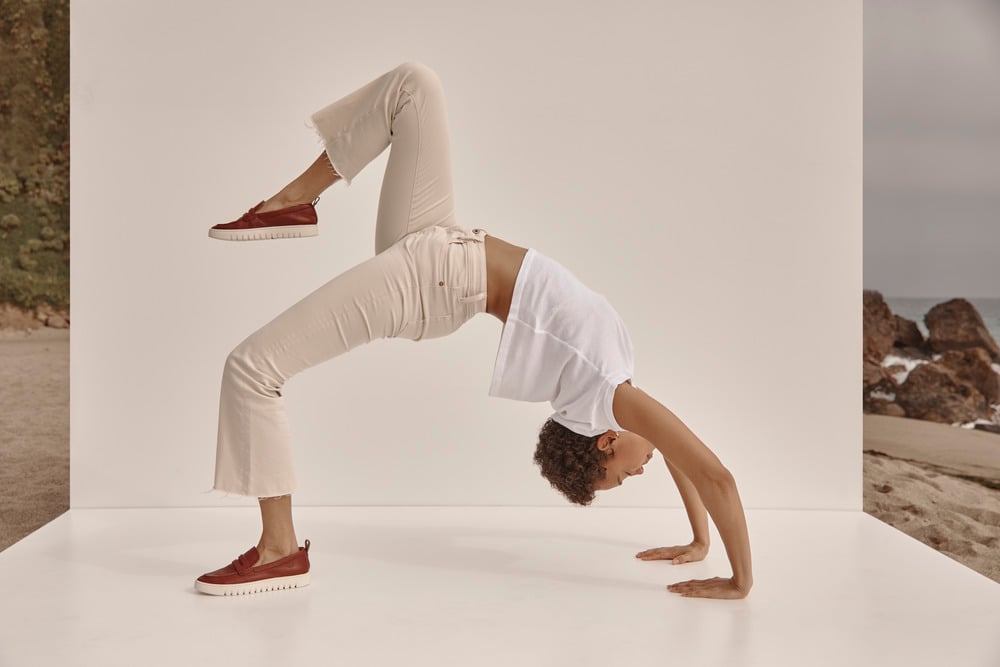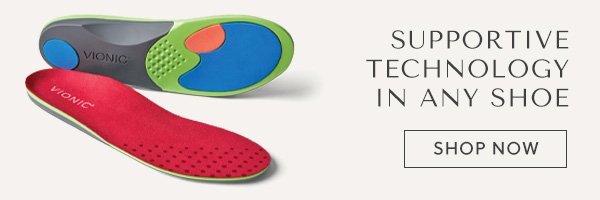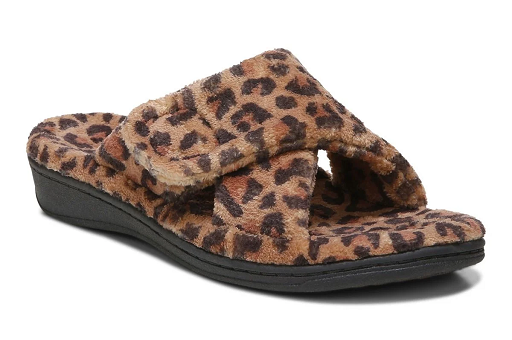
Do your feet frequently feel cold or numb? Are the hairs on your toes falling off, or does your skin feel dry? If this sounds familiar, then you may have poor circulation in your feet.
There may be a number of reasons why you’re experiencing low blood flow to parts of your body, but poor circulation can lead to serious medical conditions. That’s why it’s important to know how to improve circulation in feet if you notice a problem. It’s also important to find supportive shoes that don’t cut off circulation. Stylish shoes for men and work shoes for women that are also comfortable and supportive do exist!
To learn more about why healthy circulation is important and tips on how to rebuild blood flow to your feet, keep reading.
WHAT ARE THE CAUSES AND SYMPTOMS OF POOR CIRCULATION
If you often complain of cold feet even when it’s warm out, you may have heard from people that you probably have poor leg circulation. Low or bad circulation in the extremities—such as the feet—is common.
But persistent and worsening symptoms of bad circulation could be your body signaling to you that something is wrong. After all, the circulatory system takes care of delivering blood, oxygen, and nutrients to all the cells throughout your body that keep your physiological systems running.1
Circulation problems can be an indication of an underlying condition, such as:
Blood clots
A blood clot can develop anywhere in your body and block your blood flow, leading to leg pain and poor circulation. If left unchecked, it could lead to a stroke or other life-threatening situations. Blood clots in the feet or legs are particularly dangerous because they can break free and move through your veins into your heart and lungs.2 Identifying a blood clot early on can be pivotal to treatment, so get yourself checked out for clots if you notice circulation problems.
Diabetes
Diabetes can cause swelling, cramping, and poor foot circulation, particularly for people who are often on their feet.3 It may be difficult for advanced diabetics with loss of sensation to notice reduced circulation or low blood flow, so it’s important to get regular medical examinations.
Excess Weight
Along with a host of other health issues, obesity can place a burden on your body. A sedentary lifestyle for people who are obese can also lead to circulatory problems, which includes problems with your feet and legs.
Arteriosclerosis
This condition occurs when you have high blood pressure, and the buildup of plaque stiffens your arteries, making it difficult for blood to flow through and deliver oxygen to your organs.4
Arteriosclerosis can be caused by smoking, obesity, diabetes, or a sedentary lifestyle, and can lead to heart attack or even death.
Peripheral artery disease (PAD)
Arteriosclerosis can develop into peripheral artery disease if plaque is allowed to build up and narrow the arteries and blood vessels. The resulting poor circulation can cause foot pain, numbness, and tissue damage in your extremities.2 Like arteriosclerosis, if left untreated, PAD can lead to a stroke or heart attack.
Varicose veins
If you noticed blue, swollen veins under the skin on the backs of your legs, you may have varicose veins. This condition means that the valves in your veins aren’t functioning correctly and may cause reduced blood flow, leading to poor leg circulation.5
Raynaud’s disease
Raynaud’s disease is a condition that restricts the small blood vessel in your hands and toes.2 The narrowed arteries make it difficult for blood to flow through your veins and can lead to cold hands and feet.
The health problems associated with poor circulation are severe and can be very serious. That’s why taking preventative measures as soon as you begin to notice the signs and symptoms of poor circulation is so important. But doing so means you have to know what to look out for.
Symptoms of circulatory problems to your legs and feet include but are not limited to:6
- Discoloration (blue or purple) in the feet
- Tingling or stinging sensations
- Numbness
- Swelling
- Cold feet
- Rashes
- Aches and pain
- Spider veins
- Engorged veins
- Muscle cramps
- Dry or cracked skin
- Hair loss on your feet or legs
It’s important to consult your doctor if you notice persistent problems with your circulation, as this can indicate serious underlying conditions. Knowing when to see a podiatrist is important in order to stay one or two steps ahead where your foot health is concerned.
That said, if you’re experiencing poor circulation to your feet, you don’t have to wait for your next doctor’s appointment to start taking steps to address it. Here are some proven tips that can help you improve your foot circulation all on your own!
5 TIPS ON HOW TO IMPROVE FOOT CIRCULATION
Wondering how to get better circulation to your feet? Our experts have a few tips that might help.
Because blood circulation is an important part of how your body distributes nutrients, oxygen, and blood throughout your body, having a strong circulatory system is key to maintaining your long-term health. But how do you go about making changes if your system is already struggling to pump blood to your feet, toes, and any other lower extremity?
As always, Viconic has you covered. Keep reading for five expert tips on how to improve circulation in feet and start building the foundation for a healthier lifestyle.
#1 Get More Exercise
You’ve probably heard the mantra that we should all be getting at least 30 minutes of exercise a day. An active lifestyle with regular exercise will reduce other risk factors that can impact your circulation, such as obesity or diabetes.
If the idea of hitting the gym every day fills you with dread, you can try low-impact forms of exercise such as walking, swimming, or yoga. Walking also increases muscle contraction in your legs, which supports blood circulation in the legs and feet.7 Start small and work your way up the activity ladder until you’re hitting your step goals each day.
Try adding other simple exercises that promote circulation to your regimen, such as:8
- Knee bends
- Heel and toe raises or lifts
- Ankle pumps
- Calf stretches
- Leg lifts
- Rotating your ankles
- Squats
- Stretching with a foam roller
#2 Improve Your Diet
Building a healthy diet with plenty of fruits and vegetables goes hand in hand with exercise in improving circulation and helping your heart function. It’s also important to avoid overindulging in foods that are known to disrupt your circulation. Enjoying foods high in trans fats, saturated fats, salts, and sugars in moderation can help keep your circulatory system in good working order. It can also help you maintain a healthy weight, which means less strain on your feet.
Eating foods that can help lower your cholesterol can also reduce risk factors for obesity, diabetes, high cholesterol, and peripheral artery disease (PAD).6 Certain foods, such as pomegranates or fatty fish, can help lower blood pressure and prevent the type of buildup in your arteries that can lead to poor blood circulation and foot problems later down the road.
If you’d like to have good circulation, try adding these foods to your diet:9
- Beets
- Garlic
- Cayenne pepper
- Dark chocolate
- Berries
- Fish rich in omega-3 fatty acids (such as halibut, salmon, or trout)
- Spinach
- Nuts
- Garlic
- Carrots
- Bananas
- Pomegranates
- Black or green tea
#3 Stop Smoking
If you’re a smoker, you probably already know that there are a number of risk factors with cigarettes when it comes to your health. But did you know that smoking can contribute to having a circulation problem?
Nicotine, like caffeine, stress, or alcohol, can make your blood vessels tighten and narrow. That restriction makes it more difficult for blood to pass through your system.10
Smoking also harms your cardiovascular system and increases your chances for blood clots, heart disease, strokes, or peripheral artery disease, all potential underlying causes for poor circulation.
Quitting smoking can help reduce those risks and improve the circulation of blood to your feet.
#4 Improve Your Body Posture
Did you know your seating posture can affect your blood circulation? One of the reasons why a sedentary lifestyle can be harmful to your health is because staying seated in one position for a long time can restrict your blood vessels and make it harder for blood to flow to your muscles.11
Avoid seats that keep your legs locked in one position, or that are too high because they might place too much pressure on your thighs and cut off circulation. Crossing your legs while sitting can also restrict blood flow.
If, like a lot of people, you work in an office or other environment where sitting is par for the course, you aren’t completely without hope when it comes to keeping your blood moving. Just be sure to take periodic breaks from sitting. You can:
- Get up and move around in order to help blood circulation in your body
- Use a standing desk and alternate between standing and sitting at work
#5 Try Compression Socks
If your lifestyle means that you need to be seated or standing in one place for most of the day, you can try compression stockings to improve blood flow. Compression socks are tight-fitting socks that gently apply gradual amounts of pressure to your feet and to your legs.
But how do they work?
Compression socks are designed to squeeze your legs and feet. This helps encourage circulation because the pressure from the socks gently pushes blood flow up your legs towards your heart.12 In short, compression socks stimulate the flow of blood in your feet and legs which helps reduce the symptoms of poor circulation, like swelling, foot pain, and the risk of blood clots.
You can buy different types of compression levels, so ask your doctor which one would be best for your specific situation. Not sure if you should ask your podiatrist vs orthopedist? It’s a common question but we have the answers for you.
PUT YOUR BEST FOOT FORWARD WITH VIONIC
If you’re committed to improving circulation in your feet and plan to start building towards a more active lifestyle, make sure you’re equipped for success with Vionic. Wearing the right shoes for your specific foot types and chosen activity will help prevent injuries and give you the comfort you need.
After all, you’re less likely to keep moving if your feet feel suffocated. And, if they’re suffocated, there’s a chance that your footwear is cramping your circulation.
Here at Vionic, we provide comfortable and stylish footwear that encourages stability, proper alignment, and arch support. Whether you’re training for a 5k or starting to run a few miles a week, our shoes can help give you the support you need to improve poor circulation.
If you’re new to picking out the right shoes, learn more about the difference between walking shoes and running shoes. We also have a host of resources to help you upgrade your lifestyle and improve your overall wellness.
Sources:
- “6 Ways to Improve Poor Blood Circulation in Your Legs”. Vein Clinics of America. https://www.veinclinics.com/blog/tips-to-improve-blood-circulation-in-legs/
- Marjorie Hecht. “How to Increase Circulation in Your Legs with and Without Exercise”. Healthline. October 24, 2019, https://www.healthline.com/health/how-to-increase-circulation-in-legs#seated-exercises
- Beth Sissons. “Increasing Blood Flow: Foods and More”. Medical NewS Today. April 14, 2021, https://www.medicalnewstoday.com/articles/foods-that-increase-blood-flow#other-lifestyle-and-diet-choices
- “Ruby Cemental. “What Causes Poor Foot Circulation?”. Caring Senior Service. https://www.caringseniorservice.com/blog/what-causes-poor-foot-circulation
- Ann Pietrangelo. 26 Health Effects of Smoking on Your Body. Healthline. Updated on February 20, 2019,https//www.healthline.com/health/smoking/effects-on-body
- “Working in a Sitting Position: Overview”. Canadian Centre for Occupational Health and Safety. https://www.ccohs.ca/oshanswers/ergonomics/sitting/sitting_overview.html
- “What You Need to Know About Compression Socks Before You Buy”. Oklahoma Heart Institute. https://oklahomaheart.com/blog/what-you-need-know-about-compression-socks-you-buy
- “How Does the Blood Circulatory System Work?”. Institute for Quality and Efficiency in Health Care, 2006. https://www.ncbi.nlm.nih.gov/books/NBK279250/
- Kimberly Holland. “Symptoms and Causes of Poor Circulation”. Healthline. Updated on January 27, 2020, https://www.healthline.com/health/poor-circulation-symptoms-causes#causes
- Peripheral Vascular Associates. Foot Pain Symptoms & Causes | Poor Circulation Treatment. https://pvasatx.com/foot-pain-might-be-a-symptom-of-poor-circulation/
- “Poor Circulation in Feet: Causes, Treatments, and How to Improve It.”. Medical News Today. https://www.medicalnewstoday.com/articles/poor-circulation-in-feet#underlying-causes
- “Varicose Veins”. National Heart, Lung, and Blood Institute. https://www.nhlbi.nih.gov/health-topics/varicose-veins



Barbara Arrington
Wonderful comments! Most of my life I have had bouts of leg and foot pain. All the tips are wonderful about rotating ankles, standing on toes and the other exercises. Heel spurs had to be removed at 16, 18 started spider veins, and severe burns from a motorcycle fire at 59. My podiatrist helps sooo much! Heel spurs are coming back again at 67 and the spider veins seem to be the same as at 18. Also, over the years my weight has fluctuated. Vionic and Softina shoes are my favorites! Love, love love.